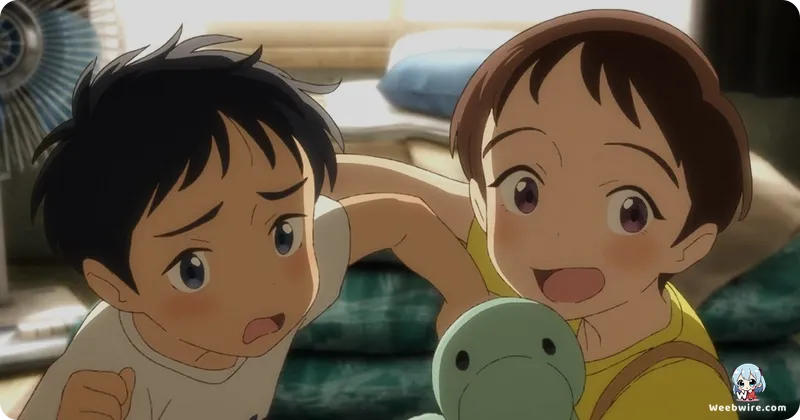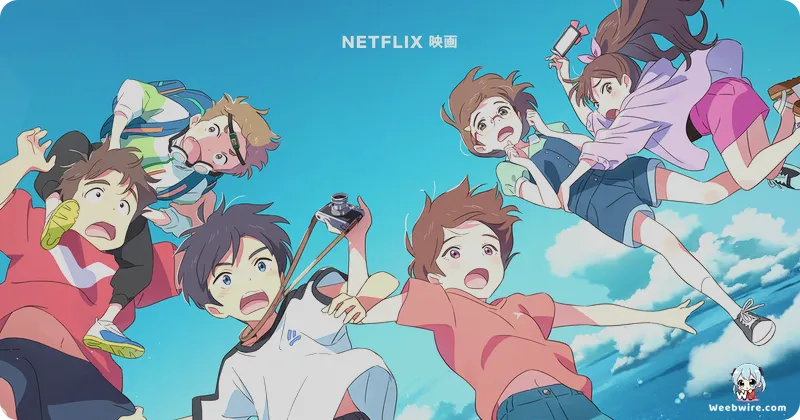Studio Colorido's 'Drifting Home': Uncharted Waters of Childhood, Memory, and Mystery Explored in Acclaimed Anime Feature

Studio Colorido's 2022 animated feature, Drifting Home, captivated audiences with its unique premise and poignant exploration of childhood, loss, and the essence of belonging. Beyond its visually striking animation and emotional narrative, the film is rich with fascinating details and behind-the-scenes insights that elevate its status as a memorable work in contemporary anime. A deeper look into these aspects reveals a profound appreciation for the artistry and thematic complexity woven into its fabric.
At its core, Drifting Home tells the story of sixth-graders Kosuke and Natsume. Along with their friends, they find themselves in an inexplicable predicament: their old, abandoned apartment complex, slated for demolition, suddenly drifts into a vast, mysterious ocean. This fantastical setup is more than just a plot device; it serves as a powerful metaphor for the turbulent transition from childhood to adolescence, a period often marked by feelings of being unmoored and disconnected from familiar anchors. The apartment building itself, a symbol of their shared past and memories, transforms into a vessel carrying them through an unknown future, mirroring their own emotional journeys.
The Artistry of Studio Colorido's World-Building
One of the most intriguing aspects of Drifting Home is its meticulous world-building, despite the fantastical nature of its premise. Studio Colorido, known for its distinctive visual style and ability to blend realism with the whimsical, truly shines here. Its previous works, such as Penguin Highway and A Whisker Away, established a reputation for crafting narratives that explore the boundary between the mundane and the magical. Drifting Home continues this tradition on a grander, more ambitious scale. The vast, empty ocean, dotted with other forgotten structures, is rendered with breathtaking detail, creating a sense of both wonder and existential dread. This commitment to visual storytelling ensures that even the most surreal elements feel grounded within the film's internal logic.

Director Hiroyasu Ishida's Signature Touch
Director Hiroyasu Ishida, who also helmed the critically acclaimed Penguin Highway, brings his signature touch to Drifting Home. Ishida is celebrated for his ability to explore complex emotional landscapes through fantastical scenarios, often focusing on the intricacies of childhood friendships and the bittersweet nature of growing up. In Drifting Home, his direction masterfully navigates the delicate balance between adventure and introspection. The children's struggles for survival against the elements are paralleled by their internal conflicts, particularly the unresolved tensions between Kosuke and Natsume concerning the death of Kosuke's grandfather and their shared past in the apartment building. This dual narrative, a hallmark of Ishida's style, allows the film to resonate on multiple levels, appealing to both a younger audience drawn to the adventure and older viewers who appreciate its psychological depth.
Exploring Memory and Grief
Another compelling aspect lies in the film's subtle exploration of memory and grief. The drifting apartment complex is not merely a physical space; it is a repository of memories, both cherished and painful. As the children explore its familiar yet now alien corridors, they confront their past, their relationships, and the specter of loss. The enigmatic character of Noppo, a mysterious boy who seems to have always been present in the apartment, embodies the lingering spirits of these memories and the building itself. His presence, often silent and observant, adds a layer of supernatural intrigue, suggesting that the past is not easily left behind and that places can hold echoes of those who once inhabited them. This nuanced approach to grief, without resorting to overt melodrama, is a testament to the film's sophisticated storytelling.
Authentic Character Designs and Emotional Impact
The character designs, overseen by Akihiro Nagae, are another highlight, giving each child a distinct personality that is immediately recognizable and relatable. From the cautious Kosuke to the more impulsive Natsume, each character feels authentic. Their reactions to the extraordinary situation – fear, excitement, frustration, and eventual resilience – are portrayed with a sincerity that anchors the fantastical premise in human emotion. The visual contrast between their youthful innocence and the overwhelming, perilous environment they find themselves in further amplifies the film's dramatic tension and emotional impact.
The Power of Sound and Music
Furthermore, the sound design and musical score play a crucial role in establishing the film's atmosphere. The vastness of the ocean, the creaking of the old building, and the quiet moments of reflection are all enhanced by an evocative soundtrack that shifts seamlessly between adventurous and melancholic tones. This sonic landscape is essential in immersing the audience in the children's isolated world, making their journey feel both immense and intimately personal. The overall effect is a deeply moving experience that lingers long after the credits roll, cementing Drifting Home as a unique and artistically rich contribution to Studio Colorido's impressive body of work.
Credits
Drifting Home
Author
Hiroyasu Ishida (Director, Original Story)
Cover Art
Akihiro Nagae (Character Designer)
Studio
Studio Colorido
Publisher
Studio Colorido
Producers





